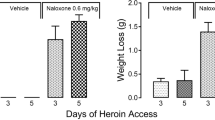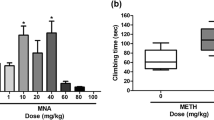Abstract
Rationale
Substantial use of the plant kratom for psychoactive effects has driven interest in its abuse liability. Several place conditioning studies suggest abuse liability of the active ingredient mitragynine, though studies of its self-administration have not been published.
Methods
Binding of mitragynine to rat brain mu, kappa, and delta opioid receptors was compared to that for heroin and morphine. Self-administration of mitragynine, heroin, methamphetamine, or saline was assessed during single-session substitutions in rats trained to self-administer methamphetamine (0.022 mg/kg/injection, i.v.) during 1-h daily sessions.
Results
Mitragynine had > 2- or ~ 16-fold greater affinity for the mu opioid receptor than, respectively, for kappa or delta opioid receptors. Its affinity for the mu receptor was ~ 200-fold less than that for morphine. In rats trained to self-administer methamphetamine, saline substitutions significantly decreased the number of responses, whereas different doses of methamphetamine (0.002–0.068 mg/kg/injection) or heroin (0.001–0.03 mg/kg/injection) maintained self-administration with maximal responding at 0.022 or 0.01 mg/kg/injection, respectively. In contrast, no dose of mitragynine maintained response rates greater than those obtained with saline. Presession mitragynine treatment (0.1 to 3.0 mg/kg) decreased response rates maintained by heroin but had little effect on responding maintained by methamphetamine across the same range of doses.
Conclusions
These results suggest a limited abuse liability of mitragynine and potential for mitragynine treatment to specifically reduce opioid abuse. With the current prevalence of opioid abuse and misuse, it appears currently that mitragynine is deserving of more extensive exploration for its development or that of an analog as a medical treatment for opioid abuse.


Similar content being viewed by others
References
Bertalmio AJ, Woods JH (1989) Reinforcing effect of alfentanil is mediated by mu opioid receptors: apparent pA2 analysis. J Pharmacol Exp Ther 251:455–460
Caggiula AR, Donny EC, Chaudhri N, Perkins KA, Evans-Martin FF, Sved AF (2002) Importance of nonpharmacological factors in nicotine self-administration. Physiol Behav 77:683–687
Cheaha D, Reakkamnuan C, Nukitram J, Chittrakarn S, Phukpattaranont P, Keawpradub N, Kumarnsit E (2017) Effects of alkaloid-rich extract from Mitragyna speciosa (Korth) Havil on naloxone-precipitated morphine withdrawal symptoms and local field potential in the nucleus accumbens of mice. J Ethnopharmacol 208:129–137
Cheng Y, Prusoff WH (1973) Relationship between the inhibition constant (KI) and the concentration which causes 50% inhibition of an enzymatic reaction. Biochem Pharmacol 22:403–411
Dole VP, Nyswander M (1965) A medical treatment for diacetylmorphine (heroin) addiction: a clinical trial with methadone hydrochloride. JAMA 193: 646–650
Grundmann O (2017) Patterns of kratom use and health impact in the US — results from an online survey. Drug Alcohol Depend 176:63–70
Harrigan SE, Downs DA (1978) Continuous intravenous naltrexone effects on morphine selfadministration in rhesus monkeys. J Pharmacol Exp Ther 204: 481–486
Harun N, Hassan Z, Navaratnam V, Mansor SM, Shoaib M (2015) Discriminative stimulus properties of mitragynine (kratom) in rats. Psychopharmacol 232:2227–2238
Hassan Z, Bosch OG, Singh D, Narayanan S, Kasinather BV, Seifritz E, Kornhuber J, Quednow BB, Müller CP (2017) Novel psychoactive substances — recent progress on neuropharmacological mechanisms of action for selected drugs. Front Psychiatry 8:152
Hemby SE, Mcintosh S, Cutler SJ, McCurdy CR (2018) Abuse liability of mitragynine and 7-hydroxymitragynine putative primary alkaloids of Mitragyna speciosa (kratom). Soc Neurosci Abstr 794:21
Henningfield JE, Fant RV, Wang DW (2018) The abuse potential of kratom according the 8 factors of the controlled substances act: implications for regulation and research. Psychopharmacol 235:573–589
Himmelsbach CK (1941) The effects of certain chemical changes on the addiction characteristics of drugs of the morphine, codeine series. J Pharmacol Exp Ther 71:41–48
Hiranita T, Kohut SJ, Soto PL, Tanda G, Kopajtic TA, Katz JL (2014) Preclinical efficacy of N-substituted benztropine analogs as antagonists of methamphetamine self-administration in rats. J Pharmacol Exp Ther 348:174–191
Inturrisi CE, Schultz M, Shin S, Umans JG, Angel L, Simon EJ (1983) Evidence from opiate binding studies that heroin acts through its metabolites. Life Sci 33(Suppl 1):773–776
Kai Y, Ma B, Chen L, Tian X, Ru Q, Gan Y, Wang D, Jin G, Li C (2014) l-Stepholidine, a naturally occurring dopamine D1 receptor agonist and D2 receptor antagonist, attenuates heroin self-administration and cue-induced reinstatement in rats. Neuroreport 25:7–11
Kohut SJ, Bergman J (2016) Reinforcing effectiveness of nicotine in nonhuman primates: effects of nicotine dose and history of nicotine self-administration. Psychopharmacol 233:2451–2458
Kong WM, Mohamed Z, Alshawsh MA, Chik Z (2017) Evaluation of pharmacokinetics and blood-brain barrier permeability of mitragynine using in vivo microdialysis technique. J Pharm Biomed Anal 143:43–47
Kruegel AC, Grundmann O (2018) The medicinal chemistry and neuropharmacology of kratom: a preliminary discussion of a promising medicinal plant and analysis of its potential for abuse. Neuropharmacol 134:108–120
Kruegel AC, Gassaway MM, Kapoor A, Váradi A, Majumdar S, Filizola M, Javitch JA, Sames D (2016) Synthetic and receptor signaling explorations of the Mitragyna alkaloids: mitragynine as an atypical molecular framework for opioid receptor modulators. J Am Chem Soc 138:6754–6764
Mechner F, Latranyi M (1963) Behavioral effects of caffeine, methamphetamine, and methylphenidate in the rat. J Exp Anal Behav 6:331–342
Oldendorf WH, Hyman S, Braun L, Oldendorf SZ (1972) Blood-brain barrier: penetration of morphine, codeine, heroin, and methadone after carotid injection. Science 178:984–986
Smith KE, Lawson T (2017) Prevalence and motivations for kratom use in a sample of substance users enrolled in a residential treatment program. Drug Alcohol Depend 180:340–348
Sufka KJ, Loria MJ, Lewellyn K, Zjawiony JK, Ali Z, Abe N, Khan IA (2014) The effect of Salvia divinorum and Mitragyna speciosa extracts, fraction and major constituents on place aversion and place preference in rats. J Ethnopharmacol 151:361–364
Swogger MT, Walsh Z (2018) Kratom use and mental health: a systematic review. Drug Alcohol Depend 183:134–140
Takayama H (2004) Chemistry and pharmacology of analgesic indole alkaloids from the rubiaceous plant, Mitragyna speciosa. Chem Pharm Bull (Tokyo) 52:916–928
US Drug Enforcement Administration (2016) Schedules of controlled substances: placement of mitragynine and 7-Hydroxymitragynine into schedule I. Federal Register. https://www.federalregister.gov/documents/2016/08/31/2016-20803/schedules-of-controlledsubstances-temporary-placement-of-mitragynine-and-7-hydroxymitragynine-into. Accessed 10 April 2017
Váradi A, Marrone GF, Palmer TC, Narayan A, Szabó MR, Le Rouzic V, Grinnell SG, Subrath JJ, Warner E, Kalra S, Hunkele A (2016) Mitragynine/Corynantheidine pseudoindoxyls as opioid analgesics with mu agonism and delta antagonism, which do not recruit β-Arrestin-2. J Med Chem 59:8381–8397
Vicknasingam B, Narayanan S, Beng GT, Mansor SM (2010) The informal use of ketum (Mitragyna speciosa) for opioid withdrawal in the northern states of peninsular Malaysia and implications for drug substitution therapy. Int J Drug Policy 21:283–288
Way EL, Kemp JW, Young JM, Grassetti DR (1960) The pharmacologic effects of heroin in relationship to its rate of biotransformation. J Pharmacol Exp Ther 129:144–154
Way EL, Young JM, Kemp JW (1965) Metabolism of heroin and its pharmacologic implications. Bull Narc 17:25–33
Winger G, Skjoldager P, Woods JH (1992) Effects of buprenorphine and other opioid agonists and antagonists on alfentanil- and cocaine-reinforced responding in rhesus monkeys. J Pharmacol Exp Ther 261:311–317
Young AM, Woods JH (1981) Maintenance of behavior by ketamine and related compounds in rhesus monkeys with different self-administration histories. J Pharmacol Exp Ther 218:720–727
Yusoff NHM, Suhaimi FW, Vadivelu RK, Hassan Z, Rümler A, Rotter A, Amato D, Dringenberg HC, Mansor SM, Navaratnam V, Müller CP (2016) Abuse potential and adverse cognitive effects of mitragynine (kratom). Addict Biol 21:98–110
Yusoff NHM, Mansor SM, Müller CP, Hassan Z (2017) Opioid receptors mediate the acquisition, but not the expression of mitragynine-induced conditioned place preference in rats. Behav Brain Res 332:1–6
Yusoff NHM, Mansor SM, Müller CP, Hassan Z (2018) Baclofen blocks the acquisition and expression of mitragynine-induced conditioned place preference in rats. Behav Brain Res 345:65–71
Zanettini C, Wilkinson DS, Katz JL (2018) Behavioral economic analysis of the effects of N-substituted benztropine analogs on cocaine self-administration in rats. Psychopharmacol 235: 47–58
Zhang F (2006) SuperState: a computer program for the control of operant behavioral experimentation. J Neurosci Methods 155:194–201
Acknowledgments
We thank Drs. Christopher R. McCurdy for the initial advice on mitragynine and James H. Woods for the advice on the writing of this report.
Funding
This project was funded by the National Natural Science Foundation of China (81302762) and the National Institute on Drug Abuse, Intramural Research Program. These studies were initiated at NIDA when Kai Yue was funded by a scholarship from the China Scholarship Council (CSC), a non-profit institution affiliated with the Ministry of Education of the P.R. China, Level 13, Building A3, No. 9 Chegongzhuang Avenue, Beijing 100044, P. R. China.
Author information
Authors and Affiliations
Corresponding author
Ethics declarations
Conflict of interest
The authors declare that they have no conflict of interest.
Rights and permissions
About this article
Cite this article
Yue, K., Kopajtic, T.A. & Katz, J.L. Abuse liability of mitragynine assessed with a self-administration procedure in rats. Psychopharmacology 235, 2823–2829 (2018). https://doi.org/10.1007/s00213-018-4974-9
Received:
Accepted:
Published:
Issue Date:
DOI: https://doi.org/10.1007/s00213-018-4974-9




